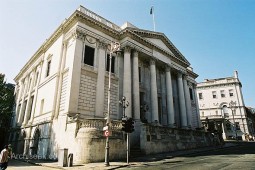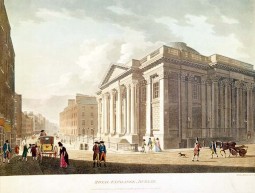
A Snippet of Dublin History (Part 11) – The Exchange
A commercial centre turned into a yeomanry torture house, then a meeting point for sedition before becoming our City Hall
In 1763, a Mr. Thomas Allen was appointed to the position of “Taster of Wines”, in the city of Dublin. After his appointment, he tried to enforce a fee of two shillings per tun on all wines imported into the country. The merchants of the city regarded this as a new form of tax and were determined to oppose it. They formed a committee of twenty one members and they collected subscriptions to defray any legal costs incurred. The struggle did not last long and did not cost as much as had been collected. The merchants had already presented a petition to Parliament, requesting some land on which to build an Exchange. Their petition was granted and they received a plot of land one hundred feet square, on Dame Street opposite Parliament Street.
They decided to use the leftover subscription money towards the erection of a building which would be a meeting place for the merchants and traders of the City. One of the city representatives, Dr. Charles Lucas, obtained thirteen thousand, five hundred pounds from Parliament towards the building and the merchants themselves conducted lotteries, raising a sum of approximately forty thousand pounds. The architectural plans of Thomas Cooley were accepted, James Gandon and T. Sandby were also involved. The Lord Lieutenant of Ireland obtained a charter incorporating the Trustees, in return for the erection of a marble bust of himself being placed in front of the new building.
He was recalled from Ireland before the foundation stone was laid. The first stone of the Royal Exchange was laid on the 2nd of August 1769, by Lord Townshend. Great celebrations were held, bells rang out and ships in the harbour displayed their colours. The Exchange was not formally opened until 1779, ten years after the foundation stone was laid. In the meanwhile, the Corporation of the City tried to gain control over the Exchange, but this move was resisted by the merchants. The only commercial dealings carried out in the Exchange were the purchase and sale of bills of exchange on England, it opened its doors three times per week for this purpose. The Exchange became a venue for public and political meetings. A writer in 1794 states “From the clang of arms the vibrating dome caught the generous flame, and re-echoed the enlivening sound of liberty, “a reference to meetings held in the Exchange by the Volunteers of Ireland.

In 1783, the Exchange was selected as a meeting place of Delegates of the National Convention for Parliamentary Reform. The building was too small for purpose and on the 10th of November 1783, the sittings were transferred to the Rotunda.
During 1798, the Exchange was converted into a military depot, manned by the Yeomanry, and courts martial were held there. During interrogation, tortures were carried out and the screams could be heard in the vicinity of the Castle. The ragged were regarded as a sign of rebellion, to have long hair a sign of hypocrisy, to have no hair a sign of sedition, and all of these were crimes meriting punishment. If a countryman visited the city to sell his wares, he could be regarded as a spy by the Yeomanry. The man would be seized, given a mock trial and, if there was no evidence of guilt, he would get a hearty kicking or worse still, a pitch-capping. No redress could be sought on the pain of being hanged.
A meeting of the Catholics of Dublin was held in the Exchange on the 13th of January 1800, to protest against the Union with Great Britain. Daniel O’Connell made his first public speech on this occasion. In 1814, nine people were killed and many severely injured when the balustrade in front of the Exchange fell down. This was as a result of the huge crowd which had gathered there to view a public whipping.
After the assimilation of currency and alterations to the banking system, the Exchange was no longer necessary. The Exchange was inaugurated as the” City Hall of the Corporation of Dublin” in September 1852.








